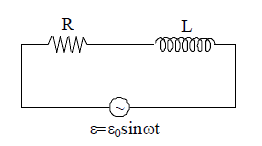What is power factor of an LCR circuit ? Explain on the basis of power factor that an ideal inductor is a wattless component.
To solve the question regarding the power factor of an LCR circuit and explain why an ideal inductor is considered a wattless component, we can break it down into the following steps:
Step 1: Define Power Factor in an LCR Circuit
- The power factor (PF) of an LCR circuit is defined as the cosine of the phase angle (φ) between the voltage across the circuit and the current flowing through it.
- Mathematically, it is expressed as:
Power Factor (PF)=cos(ϕ)
- The power developed in the circuit can be expressed as:
P=IRMS⋅VRMS⋅cos(ϕ)
where IRMS is the root mean square current, VRMS is the root mean square voltage, and ϕ is the phase angle.
Step 2: Analyze the Ideal Inductor
- An ideal inductor is characterized by having no resistance (R = 0). When connected to an AC source, the current lags the voltage by 90 degrees (π/2 radians).
- Therefore, in an ideal inductor:
ϕ=90∘
Step 3: Calculate the Power Factor for an Ideal Inductor
- Substitute φ into the power factor formula:
PF=cos(90∘)=0
Step 4: Determine the Power Developed in the Circuit
- Using the power formula:
P=IRMS⋅VRMS⋅cos(90∘)
- Since cos(90∘)=0, the power developed becomes:
P=IRMS⋅VRMS⋅0=0
Step 5: Conclusion
- Since no power is developed in an ideal inductor, it is considered a "wattless" component. This means that it does not consume any real power, which is why it is referred to as a worthless component in terms of power consumption.
- The power factor (PF) of an LCR circuit is defined as the cosine of the phase angle (φ) between the voltage across the circuit and the current flowing through it.
- Mathematically, it is expressed as:
Power Factor (PF)=cos(ϕ)
- The power developed in the circuit can be expressed as:
P=IRMS⋅VRMS⋅cos(ϕ)
where IRMS is the root mean square current, VRMS is the root mean square voltage, and ϕ is the phase angle.
- An ideal inductor is characterized by having no resistance (R = 0). When connected to an AC source, the current lags the voltage by 90 degrees (π/2 radians).
- Therefore, in an ideal inductor:
ϕ=90∘
- Substitute φ into the power factor formula:
PF=cos(90∘)=0
- Using the power formula:
P=IRMS⋅VRMS⋅cos(90∘)
- Since cos(90∘)=0, the power developed becomes:
P=IRMS⋅VRMS⋅0=0
- Since no power is developed in an ideal inductor, it is considered a "wattless" component. This means that it does not consume any real power, which is why it is referred to as a worthless component in terms of power consumption.
Topper's Solved these Questions
Similar Questions
Knowledge Check
The power factor of L-R circuit is-
AωLRBR√(ωL)2+R2CωLRD√ωLRThe power factor of a circuit is
AZ/RBR/ZCR/XDX/RPower factor of the circuit is –
 ARωLBR√R2+ω2L2CRR2+ω2L2Dnone of these
ARωLBR√R2+ω2L2CRR2+ω2L2Dnone of these
The power factor in LCR series circuit at resonance is
View SolutionThe power factor of LCR circuit at resonance is-
View SolutionThe power factor is an L-C-R circuit at resonance is
View SolutionThe power factor of LCR a.c. circuit at resonance is
View SolutionThe power factor of the circuit shown in the figure is

View Solution

